Principles of Administration: Health and Safety Course Workbook
VerifiedAdded on 2023/01/18
|29
|7928
|72
Homework Assignment
AI Summary
This course workbook assignment focuses on the principles of administration, specifically addressing health and safety within a business environment. The assignment covers the Health and Safety at Work Act 1974, detailing the legal obligations of employers to provide a safe working environment, including safe systems, equipment, and welfare facilities. It also outlines the responsibilities of employees to take care of their own and others' safety and to cooperate with employers. The assignment explores accident and emergency procedures, including training, company rules, and emergency arrangements. It also touches upon data protection, emphasizing the importance of maintaining security and confidentiality of physical property and information. The workbook includes definitions of key terms, and requires the student to explain legal obligations, individual responsibilities, and describe accident and emergency procedures, referencing relevant regulations and policies. The assignment is designed for a Level 3 Diploma in Business Administration, helping students understand and apply health and safety practices in a professional setting.
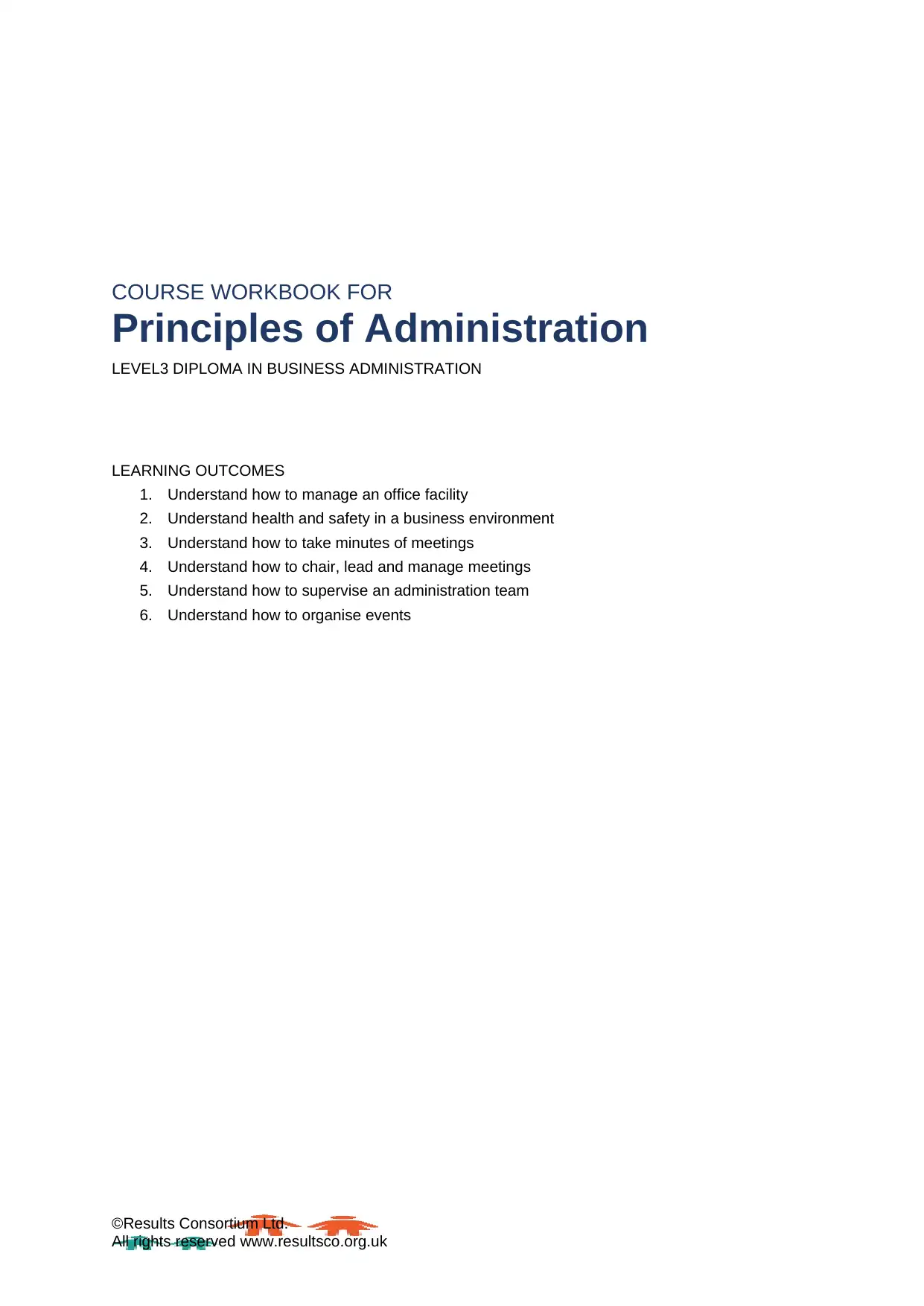
COURSE WORKBOOK FOR
Principles of Administration
LEVEL3 DIPLOMA IN BUSINESS ADMINISTRATION
LEARNING OUTCOMES
1. Understand how to manage an office facility
2. Understand health and safety in a business environment
3. Understand how to take minutes of meetings
4. Understand how to chair, lead and manage meetings
5. Understand how to supervise an administration team
6. Understand how to organise events
©Results Consortium Ltd.
All rights reserved www.resultsco.org.uk
Principles of Administration
LEVEL3 DIPLOMA IN BUSINESS ADMINISTRATION
LEARNING OUTCOMES
1. Understand how to manage an office facility
2. Understand health and safety in a business environment
3. Understand how to take minutes of meetings
4. Understand how to chair, lead and manage meetings
5. Understand how to supervise an administration team
6. Understand how to organise events
©Results Consortium Ltd.
All rights reserved www.resultsco.org.uk
Paraphrase This Document
Need a fresh take? Get an instant paraphrase of this document with our AI Paraphraser
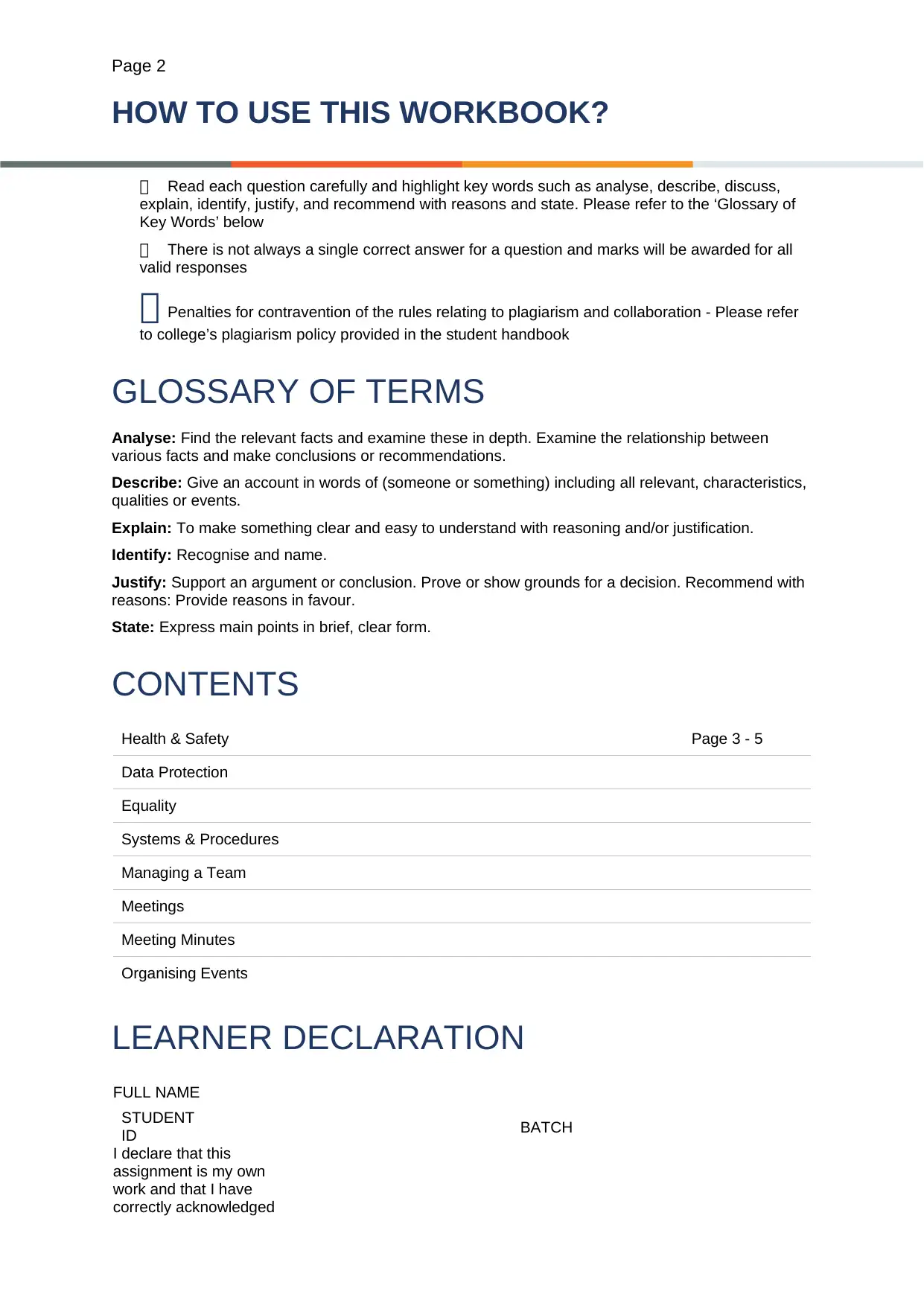
Page 2
HOW TO USE THIS WORKBOOK?
Read each question carefully and highlight key words such as analyse, describe, discuss,
explain, identify, justify, and recommend with reasons and state. Please refer to the ‘Glossary of
Key Words’ below
There is not always a single correct answer for a question and marks will be awarded for all
valid responses
Penalties for contravention of the rules relating to plagiarism and collaboration - Please refer
to college’s plagiarism policy provided in the student handbook
GLOSSARY OF TERMS
Analyse: Find the relevant facts and examine these in depth. Examine the relationship between
various facts and make conclusions or recommendations.
Describe: Give an account in words of (someone or something) including all relevant, characteristics,
qualities or events.
Explain: To make something clear and easy to understand with reasoning and/or justification.
Identify: Recognise and name.
Justify: Support an argument or conclusion. Prove or show grounds for a decision. Recommend with
reasons: Provide reasons in favour.
State: Express main points in brief, clear form.
CONTENTS
Health & Safety Page 3 - 5
Data Protection
Equality
Systems & Procedures
Managing a Team
Meetings
Meeting Minutes
Organising Events
LEARNER DECLARATION
FULL NAME
STUDENT
ID BATCH
I declare that this
assignment is my own
work and that I have
correctly acknowledged
HOW TO USE THIS WORKBOOK?
Read each question carefully and highlight key words such as analyse, describe, discuss,
explain, identify, justify, and recommend with reasons and state. Please refer to the ‘Glossary of
Key Words’ below
There is not always a single correct answer for a question and marks will be awarded for all
valid responses
Penalties for contravention of the rules relating to plagiarism and collaboration - Please refer
to college’s plagiarism policy provided in the student handbook
GLOSSARY OF TERMS
Analyse: Find the relevant facts and examine these in depth. Examine the relationship between
various facts and make conclusions or recommendations.
Describe: Give an account in words of (someone or something) including all relevant, characteristics,
qualities or events.
Explain: To make something clear and easy to understand with reasoning and/or justification.
Identify: Recognise and name.
Justify: Support an argument or conclusion. Prove or show grounds for a decision. Recommend with
reasons: Provide reasons in favour.
State: Express main points in brief, clear form.
CONTENTS
Health & Safety Page 3 - 5
Data Protection
Equality
Systems & Procedures
Managing a Team
Meetings
Meeting Minutes
Organising Events
LEARNER DECLARATION
FULL NAME
STUDENT
ID BATCH
I declare that this
assignment is my own
work and that I have
correctly acknowledged
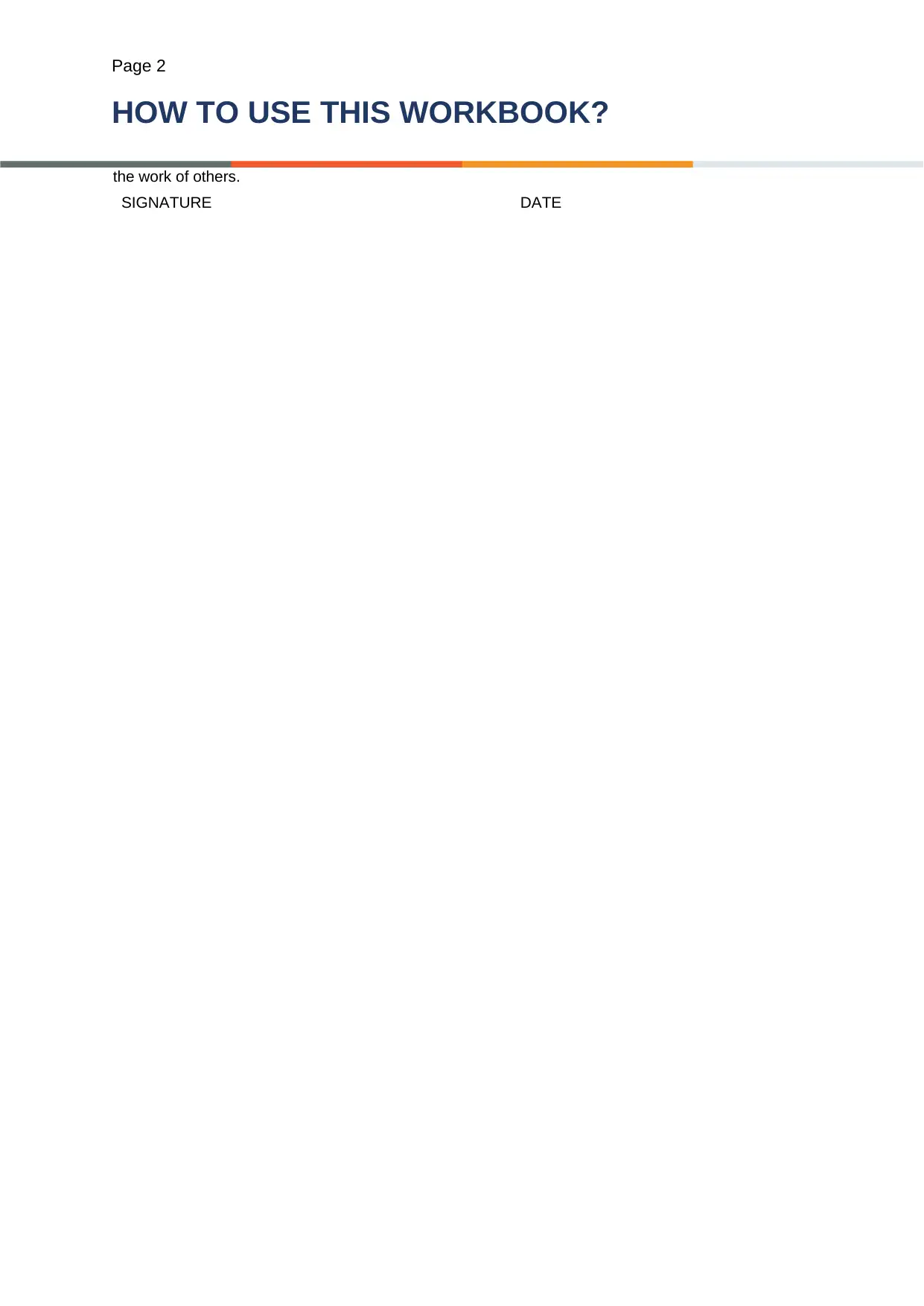
Page 2
HOW TO USE THIS WORKBOOK?
the work of others.
SIGNATURE DATE
HOW TO USE THIS WORKBOOK?
the work of others.
SIGNATURE DATE
⊘ This is a preview!⊘
Do you want full access?
Subscribe today to unlock all pages.

Trusted by 1+ million students worldwide
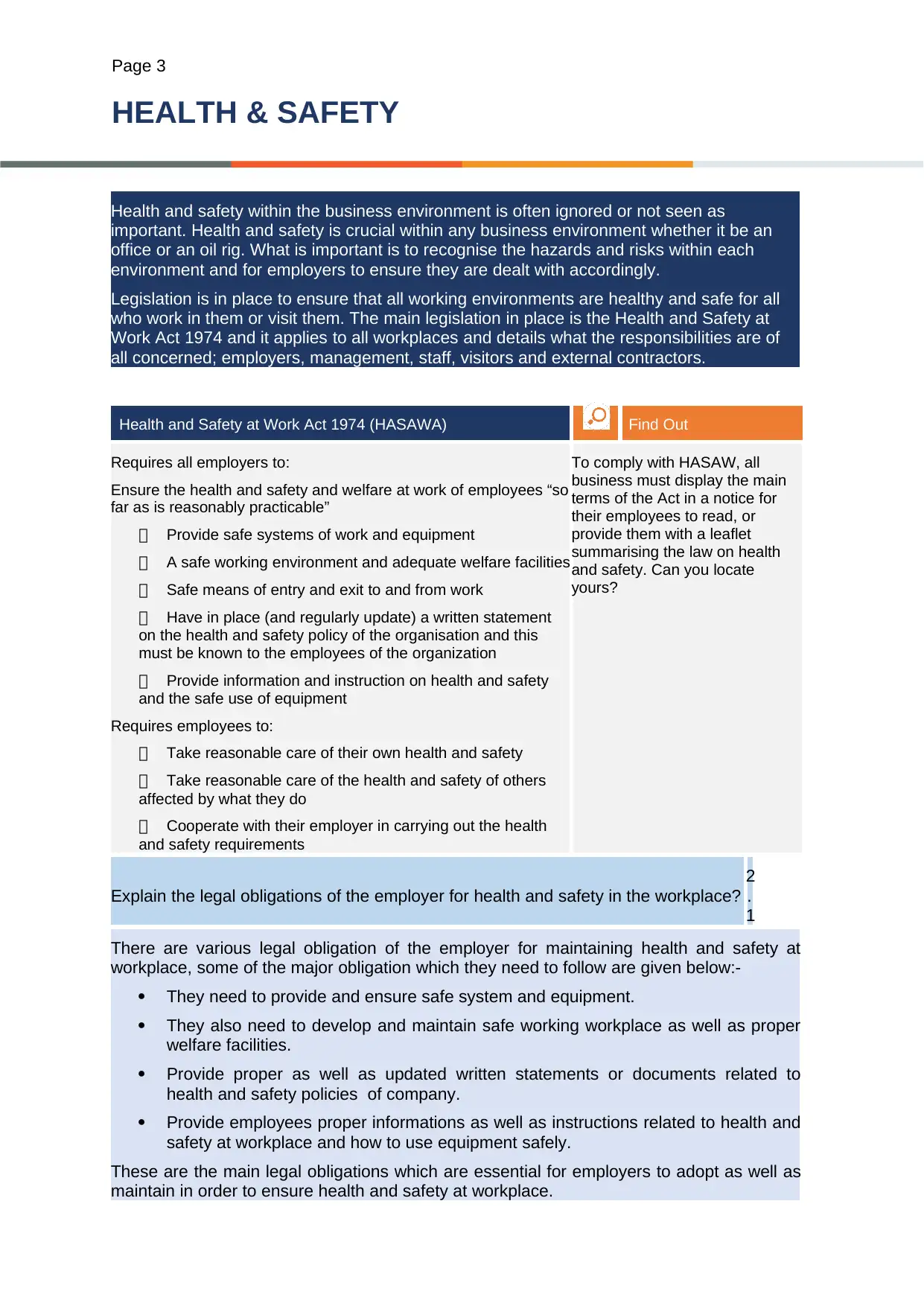
Page 3
HEALTH & SAFETY
Health and safety within the business environment is often ignored or not seen as
important. Health and safety is crucial within any business environment whether it be an
office or an oil rig. What is important is to recognise the hazards and risks within each
environment and for employers to ensure they are dealt with accordingly.
Legislation is in place to ensure that all working environments are healthy and safe for all
who work in them or visit them. The main legislation in place is the Health and Safety at
Work Act 1974 and it applies to all workplaces and details what the responsibilities are of
all concerned; employers, management, staff, visitors and external contractors.
Health and Safety at Work Act 1974 (HASAWA) Find Out
Requires all employers to:
Ensure the health and safety and welfare at work of employees “so
far as is reasonably practicable”
Provide safe systems of work and equipment
A safe working environment and adequate welfare facilities
Safe means of entry and exit to and from work
Have in place (and regularly update) a written statement
on the health and safety policy of the organisation and this
must be known to the employees of the organization
Provide information and instruction on health and safety
and the safe use of equipment
Requires employees to:
Take reasonable care of their own health and safety
Take reasonable care of the health and safety of others
affected by what they do
Cooperate with their employer in carrying out the health
and safety requirements
To comply with HASAW, all
business must display the main
terms of the Act in a notice for
their employees to read, or
provide them with a leaflet
summarising the law on health
and safety. Can you locate
yours?
Explain the legal obligations of the employer for health and safety in the workplace?
2
.
1
There are various legal obligation of the employer for maintaining health and safety at
workplace, some of the major obligation which they need to follow are given below:-
They need to provide and ensure safe system and equipment.
They also need to develop and maintain safe working workplace as well as proper
welfare facilities.
Provide proper as well as updated written statements or documents related to
health and safety policies of company.
Provide employees proper informations as well as instructions related to health and
safety at workplace and how to use equipment safely.
These are the main legal obligations which are essential for employers to adopt as well as
maintain in order to ensure health and safety at workplace.
HEALTH & SAFETY
Health and safety within the business environment is often ignored or not seen as
important. Health and safety is crucial within any business environment whether it be an
office or an oil rig. What is important is to recognise the hazards and risks within each
environment and for employers to ensure they are dealt with accordingly.
Legislation is in place to ensure that all working environments are healthy and safe for all
who work in them or visit them. The main legislation in place is the Health and Safety at
Work Act 1974 and it applies to all workplaces and details what the responsibilities are of
all concerned; employers, management, staff, visitors and external contractors.
Health and Safety at Work Act 1974 (HASAWA) Find Out
Requires all employers to:
Ensure the health and safety and welfare at work of employees “so
far as is reasonably practicable”
Provide safe systems of work and equipment
A safe working environment and adequate welfare facilities
Safe means of entry and exit to and from work
Have in place (and regularly update) a written statement
on the health and safety policy of the organisation and this
must be known to the employees of the organization
Provide information and instruction on health and safety
and the safe use of equipment
Requires employees to:
Take reasonable care of their own health and safety
Take reasonable care of the health and safety of others
affected by what they do
Cooperate with their employer in carrying out the health
and safety requirements
To comply with HASAW, all
business must display the main
terms of the Act in a notice for
their employees to read, or
provide them with a leaflet
summarising the law on health
and safety. Can you locate
yours?
Explain the legal obligations of the employer for health and safety in the workplace?
2
.
1
There are various legal obligation of the employer for maintaining health and safety at
workplace, some of the major obligation which they need to follow are given below:-
They need to provide and ensure safe system and equipment.
They also need to develop and maintain safe working workplace as well as proper
welfare facilities.
Provide proper as well as updated written statements or documents related to
health and safety policies of company.
Provide employees proper informations as well as instructions related to health and
safety at workplace and how to use equipment safely.
These are the main legal obligations which are essential for employers to adopt as well as
maintain in order to ensure health and safety at workplace.
Paraphrase This Document
Need a fresh take? Get an instant paraphrase of this document with our AI Paraphraser
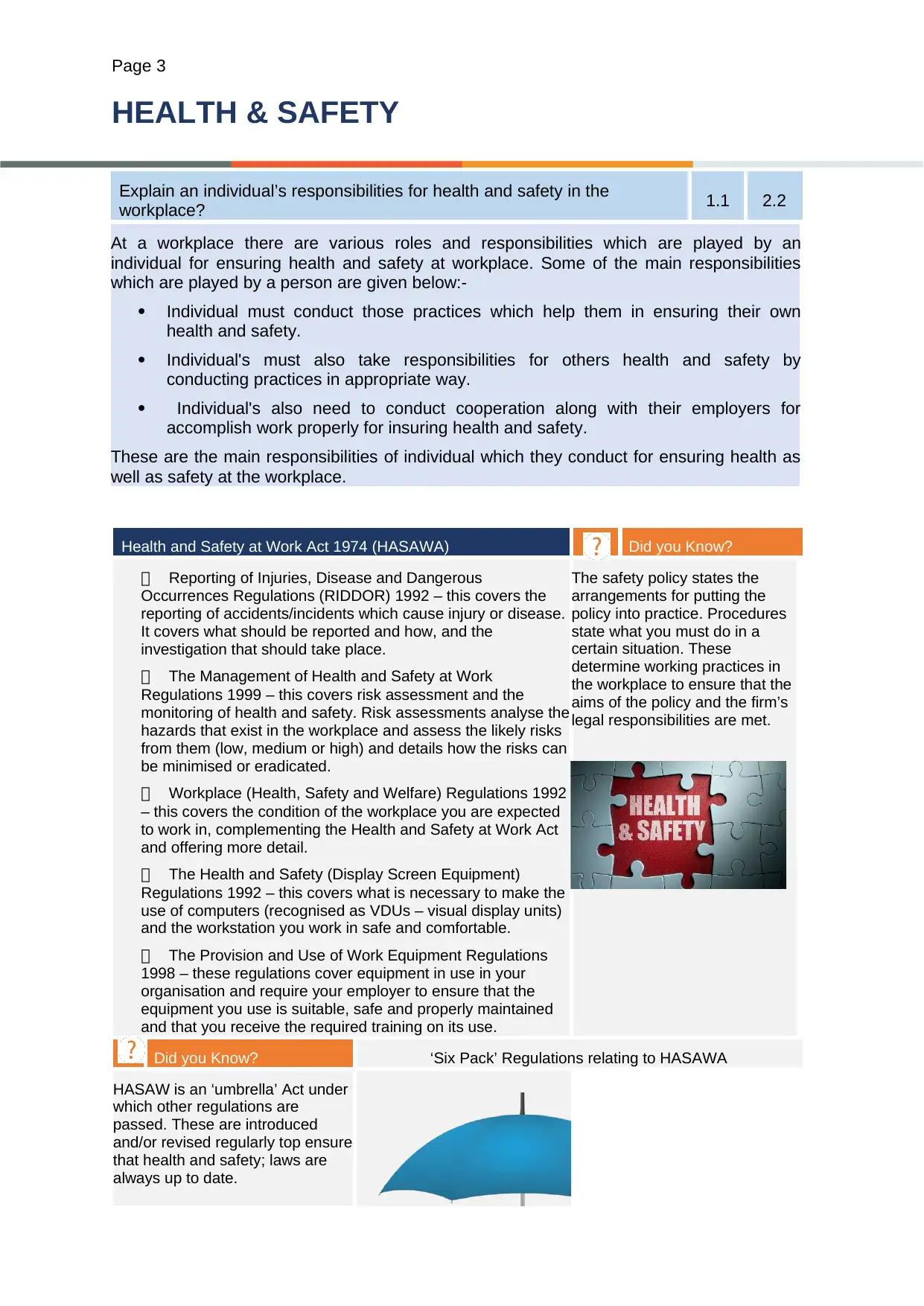
Page 3
HEALTH & SAFETY
Explain an individual’s responsibilities for health and safety in the
workplace? 1.1 2.2
At a workplace there are various roles and responsibilities which are played by an
individual for ensuring health and safety at workplace. Some of the main responsibilities
which are played by a person are given below:-
Individual must conduct those practices which help them in ensuring their own
health and safety.
Individual's must also take responsibilities for others health and safety by
conducting practices in appropriate way.
Individual's also need to conduct cooperation along with their employers for
accomplish work properly for insuring health and safety.
These are the main responsibilities of individual which they conduct for ensuring health as
well as safety at the workplace.
Health and Safety at Work Act 1974 (HASAWA) Did you Know?
Reporting of Injuries, Disease and Dangerous
Occurrences Regulations (RIDDOR) 1992 – this covers the
reporting of accidents/incidents which cause injury or disease.
It covers what should be reported and how, and the
investigation that should take place.
The Management of Health and Safety at Work
Regulations 1999 – this covers risk assessment and the
monitoring of health and safety. Risk assessments analyse the
hazards that exist in the workplace and assess the likely risks
from them (low, medium or high) and details how the risks can
be minimised or eradicated.
Workplace (Health, Safety and Welfare) Regulations 1992
– this covers the condition of the workplace you are expected
to work in, complementing the Health and Safety at Work Act
and offering more detail.
The Health and Safety (Display Screen Equipment)
Regulations 1992 – this covers what is necessary to make the
use of computers (recognised as VDUs – visual display units)
and the workstation you work in safe and comfortable.
The Provision and Use of Work Equipment Regulations
1998 – these regulations cover equipment in use in your
organisation and require your employer to ensure that the
equipment you use is suitable, safe and properly maintained
and that you receive the required training on its use.
The safety policy states the
arrangements for putting the
policy into practice. Procedures
state what you must do in a
certain situation. These
determine working practices in
the workplace to ensure that the
aims of the policy and the firm’s
legal responsibilities are met.
Did you Know? ‘Six Pack’ Regulations relating to HASAWA
HASAW is an ‘umbrella’ Act under
which other regulations are
passed. These are introduced
and/or revised regularly top ensure
that health and safety; laws are
always up to date.
HEALTH & SAFETY
Explain an individual’s responsibilities for health and safety in the
workplace? 1.1 2.2
At a workplace there are various roles and responsibilities which are played by an
individual for ensuring health and safety at workplace. Some of the main responsibilities
which are played by a person are given below:-
Individual must conduct those practices which help them in ensuring their own
health and safety.
Individual's must also take responsibilities for others health and safety by
conducting practices in appropriate way.
Individual's also need to conduct cooperation along with their employers for
accomplish work properly for insuring health and safety.
These are the main responsibilities of individual which they conduct for ensuring health as
well as safety at the workplace.
Health and Safety at Work Act 1974 (HASAWA) Did you Know?
Reporting of Injuries, Disease and Dangerous
Occurrences Regulations (RIDDOR) 1992 – this covers the
reporting of accidents/incidents which cause injury or disease.
It covers what should be reported and how, and the
investigation that should take place.
The Management of Health and Safety at Work
Regulations 1999 – this covers risk assessment and the
monitoring of health and safety. Risk assessments analyse the
hazards that exist in the workplace and assess the likely risks
from them (low, medium or high) and details how the risks can
be minimised or eradicated.
Workplace (Health, Safety and Welfare) Regulations 1992
– this covers the condition of the workplace you are expected
to work in, complementing the Health and Safety at Work Act
and offering more detail.
The Health and Safety (Display Screen Equipment)
Regulations 1992 – this covers what is necessary to make the
use of computers (recognised as VDUs – visual display units)
and the workstation you work in safe and comfortable.
The Provision and Use of Work Equipment Regulations
1998 – these regulations cover equipment in use in your
organisation and require your employer to ensure that the
equipment you use is suitable, safe and properly maintained
and that you receive the required training on its use.
The safety policy states the
arrangements for putting the
policy into practice. Procedures
state what you must do in a
certain situation. These
determine working practices in
the workplace to ensure that the
aims of the policy and the firm’s
legal responsibilities are met.
Did you Know? ‘Six Pack’ Regulations relating to HASAWA
HASAW is an ‘umbrella’ Act under
which other regulations are
passed. These are introduced
and/or revised regularly top ensure
that health and safety; laws are
always up to date.
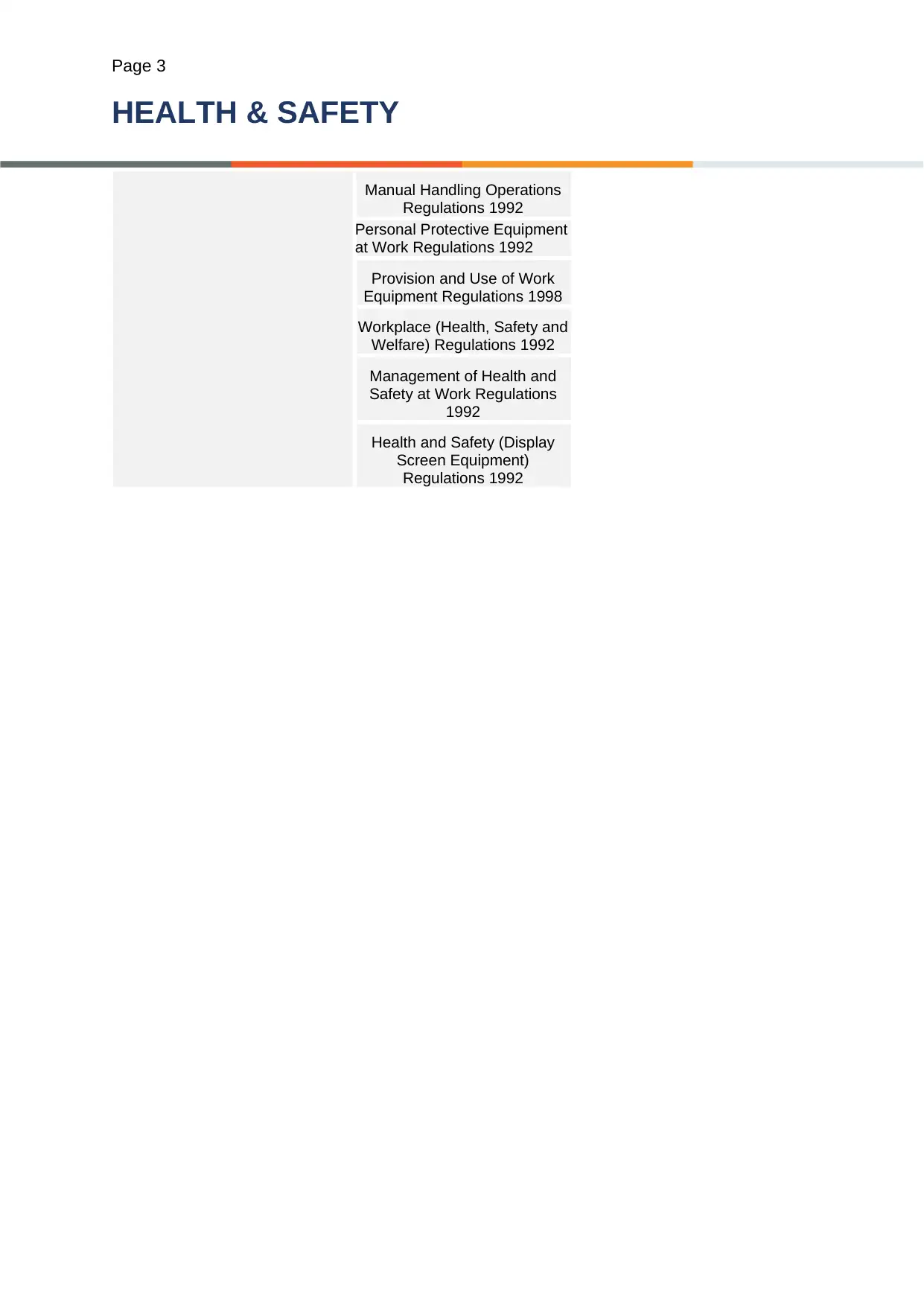
Page 3
HEALTH & SAFETY
Manual Handling Operations
Regulations 1992
Personal Protective Equipment
at Work Regulations 1992
Provision and Use of Work
Equipment Regulations 1998
Workplace (Health, Safety and
Welfare) Regulations 1992
Management of Health and
Safety at Work Regulations
1992
Health and Safety (Display
Screen Equipment)
Regulations 1992
HEALTH & SAFETY
Manual Handling Operations
Regulations 1992
Personal Protective Equipment
at Work Regulations 1992
Provision and Use of Work
Equipment Regulations 1998
Workplace (Health, Safety and
Welfare) Regulations 1992
Management of Health and
Safety at Work Regulations
1992
Health and Safety (Display
Screen Equipment)
Regulations 1992
⊘ This is a preview!⊘
Do you want full access?
Subscribe today to unlock all pages.

Trusted by 1+ million students worldwide
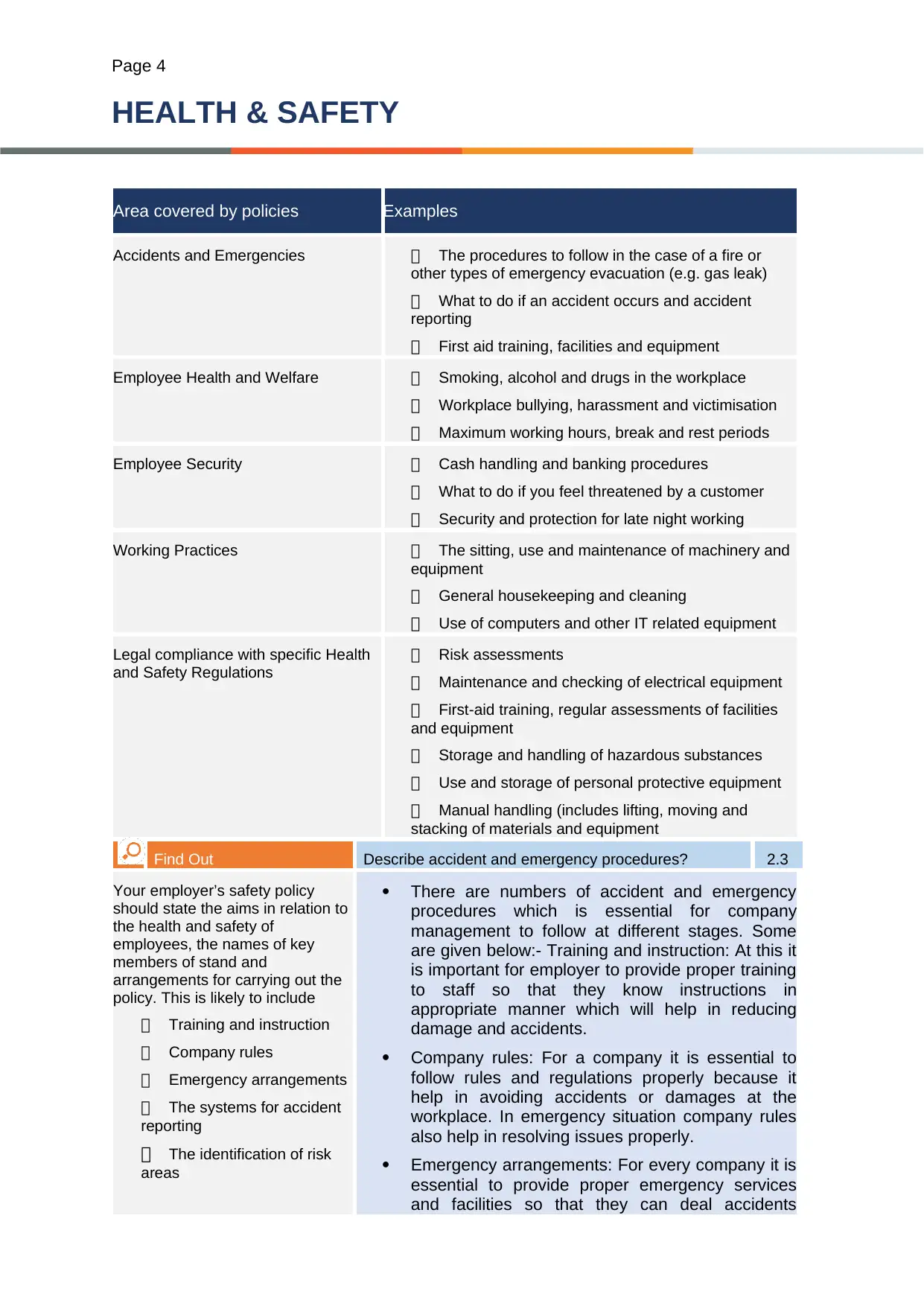
Page 4
HEALTH & SAFETY
Area covered by policies Examples
Accidents and Emergencies The procedures to follow in the case of a fire or
other types of emergency evacuation (e.g. gas leak)
What to do if an accident occurs and accident
reporting
First aid training, facilities and equipment
Employee Health and Welfare Smoking, alcohol and drugs in the workplace
Workplace bullying, harassment and victimisation
Maximum working hours, break and rest periods
Employee Security Cash handling and banking procedures
What to do if you feel threatened by a customer
Security and protection for late night working
Working Practices The sitting, use and maintenance of machinery and
equipment
General housekeeping and cleaning
Use of computers and other IT related equipment
Legal compliance with specific Health
and Safety Regulations
Risk assessments
Maintenance and checking of electrical equipment
First-aid training, regular assessments of facilities
and equipment
Storage and handling of hazardous substances
Use and storage of personal protective equipment
Manual handling (includes lifting, moving and
stacking of materials and equipment
Find Out Describe accident and emergency procedures? 2.3
Your employer’s safety policy
should state the aims in relation to
the health and safety of
employees, the names of key
members of stand and
arrangements for carrying out the
policy. This is likely to include
Training and instruction
Company rules
Emergency arrangements
The systems for accident
reporting
The identification of risk
areas
There are numbers of accident and emergency
procedures which is essential for company
management to follow at different stages. Some
are given below:- Training and instruction: At this it
is important for employer to provide proper training
to staff so that they know instructions in
appropriate manner which will help in reducing
damage and accidents.
Company rules: For a company it is essential to
follow rules and regulations properly because it
help in avoiding accidents or damages at the
workplace. In emergency situation company rules
also help in resolving issues properly.
Emergency arrangements: For every company it is
essential to provide proper emergency services
and facilities so that they can deal accidents
HEALTH & SAFETY
Area covered by policies Examples
Accidents and Emergencies The procedures to follow in the case of a fire or
other types of emergency evacuation (e.g. gas leak)
What to do if an accident occurs and accident
reporting
First aid training, facilities and equipment
Employee Health and Welfare Smoking, alcohol and drugs in the workplace
Workplace bullying, harassment and victimisation
Maximum working hours, break and rest periods
Employee Security Cash handling and banking procedures
What to do if you feel threatened by a customer
Security and protection for late night working
Working Practices The sitting, use and maintenance of machinery and
equipment
General housekeeping and cleaning
Use of computers and other IT related equipment
Legal compliance with specific Health
and Safety Regulations
Risk assessments
Maintenance and checking of electrical equipment
First-aid training, regular assessments of facilities
and equipment
Storage and handling of hazardous substances
Use and storage of personal protective equipment
Manual handling (includes lifting, moving and
stacking of materials and equipment
Find Out Describe accident and emergency procedures? 2.3
Your employer’s safety policy
should state the aims in relation to
the health and safety of
employees, the names of key
members of stand and
arrangements for carrying out the
policy. This is likely to include
Training and instruction
Company rules
Emergency arrangements
The systems for accident
reporting
The identification of risk
areas
There are numbers of accident and emergency
procedures which is essential for company
management to follow at different stages. Some
are given below:- Training and instruction: At this it
is important for employer to provide proper training
to staff so that they know instructions in
appropriate manner which will help in reducing
damage and accidents.
Company rules: For a company it is essential to
follow rules and regulations properly because it
help in avoiding accidents or damages at the
workplace. In emergency situation company rules
also help in resolving issues properly.
Emergency arrangements: For every company it is
essential to provide proper emergency services
and facilities so that they can deal accidents
Paraphrase This Document
Need a fresh take? Get an instant paraphrase of this document with our AI Paraphraser
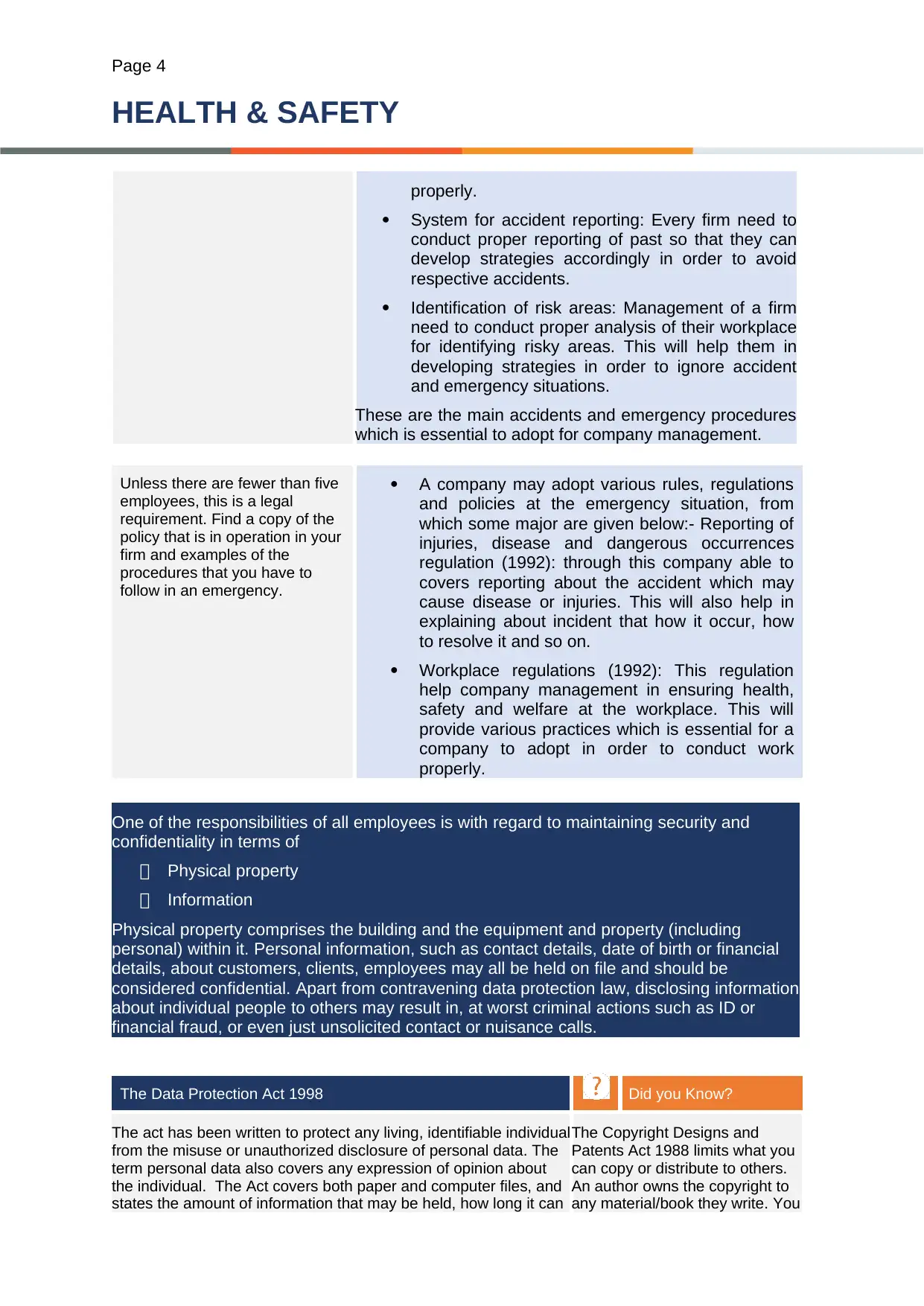
Page 4
HEALTH & SAFETY
properly.
System for accident reporting: Every firm need to
conduct proper reporting of past so that they can
develop strategies accordingly in order to avoid
respective accidents.
Identification of risk areas: Management of a firm
need to conduct proper analysis of their workplace
for identifying risky areas. This will help them in
developing strategies in order to ignore accident
and emergency situations.
These are the main accidents and emergency procedures
which is essential to adopt for company management.
Unless there are fewer than five
employees, this is a legal
requirement. Find a copy of the
policy that is in operation in your
firm and examples of the
procedures that you have to
follow in an emergency.
A company may adopt various rules, regulations
and policies at the emergency situation, from
which some major are given below:- Reporting of
injuries, disease and dangerous occurrences
regulation (1992): through this company able to
covers reporting about the accident which may
cause disease or injuries. This will also help in
explaining about incident that how it occur, how
to resolve it and so on.
Workplace regulations (1992): This regulation
help company management in ensuring health,
safety and welfare at the workplace. This will
provide various practices which is essential for a
company to adopt in order to conduct work
properly.
One of the responsibilities of all employees is with regard to maintaining security and
confidentiality in terms of
Physical property
Information
Physical property comprises the building and the equipment and property (including
personal) within it. Personal information, such as contact details, date of birth or financial
details, about customers, clients, employees may all be held on file and should be
considered confidential. Apart from contravening data protection law, disclosing information
about individual people to others may result in, at worst criminal actions such as ID or
financial fraud, or even just unsolicited contact or nuisance calls.
The Data Protection Act 1998 Did you Know?
The act has been written to protect any living, identifiable individual
from the misuse or unauthorized disclosure of personal data. The
term personal data also covers any expression of opinion about
the individual. The Act covers both paper and computer files, and
states the amount of information that may be held, how long it can
The Copyright Designs and
Patents Act 1988 limits what you
can copy or distribute to others.
An author owns the copyright to
any material/book they write. You
HEALTH & SAFETY
properly.
System for accident reporting: Every firm need to
conduct proper reporting of past so that they can
develop strategies accordingly in order to avoid
respective accidents.
Identification of risk areas: Management of a firm
need to conduct proper analysis of their workplace
for identifying risky areas. This will help them in
developing strategies in order to ignore accident
and emergency situations.
These are the main accidents and emergency procedures
which is essential to adopt for company management.
Unless there are fewer than five
employees, this is a legal
requirement. Find a copy of the
policy that is in operation in your
firm and examples of the
procedures that you have to
follow in an emergency.
A company may adopt various rules, regulations
and policies at the emergency situation, from
which some major are given below:- Reporting of
injuries, disease and dangerous occurrences
regulation (1992): through this company able to
covers reporting about the accident which may
cause disease or injuries. This will also help in
explaining about incident that how it occur, how
to resolve it and so on.
Workplace regulations (1992): This regulation
help company management in ensuring health,
safety and welfare at the workplace. This will
provide various practices which is essential for a
company to adopt in order to conduct work
properly.
One of the responsibilities of all employees is with regard to maintaining security and
confidentiality in terms of
Physical property
Information
Physical property comprises the building and the equipment and property (including
personal) within it. Personal information, such as contact details, date of birth or financial
details, about customers, clients, employees may all be held on file and should be
considered confidential. Apart from contravening data protection law, disclosing information
about individual people to others may result in, at worst criminal actions such as ID or
financial fraud, or even just unsolicited contact or nuisance calls.
The Data Protection Act 1998 Did you Know?
The act has been written to protect any living, identifiable individual
from the misuse or unauthorized disclosure of personal data. The
term personal data also covers any expression of opinion about
the individual. The Act covers both paper and computer files, and
states the amount of information that may be held, how long it can
The Copyright Designs and
Patents Act 1988 limits what you
can copy or distribute to others.
An author owns the copyright to
any material/book they write. You
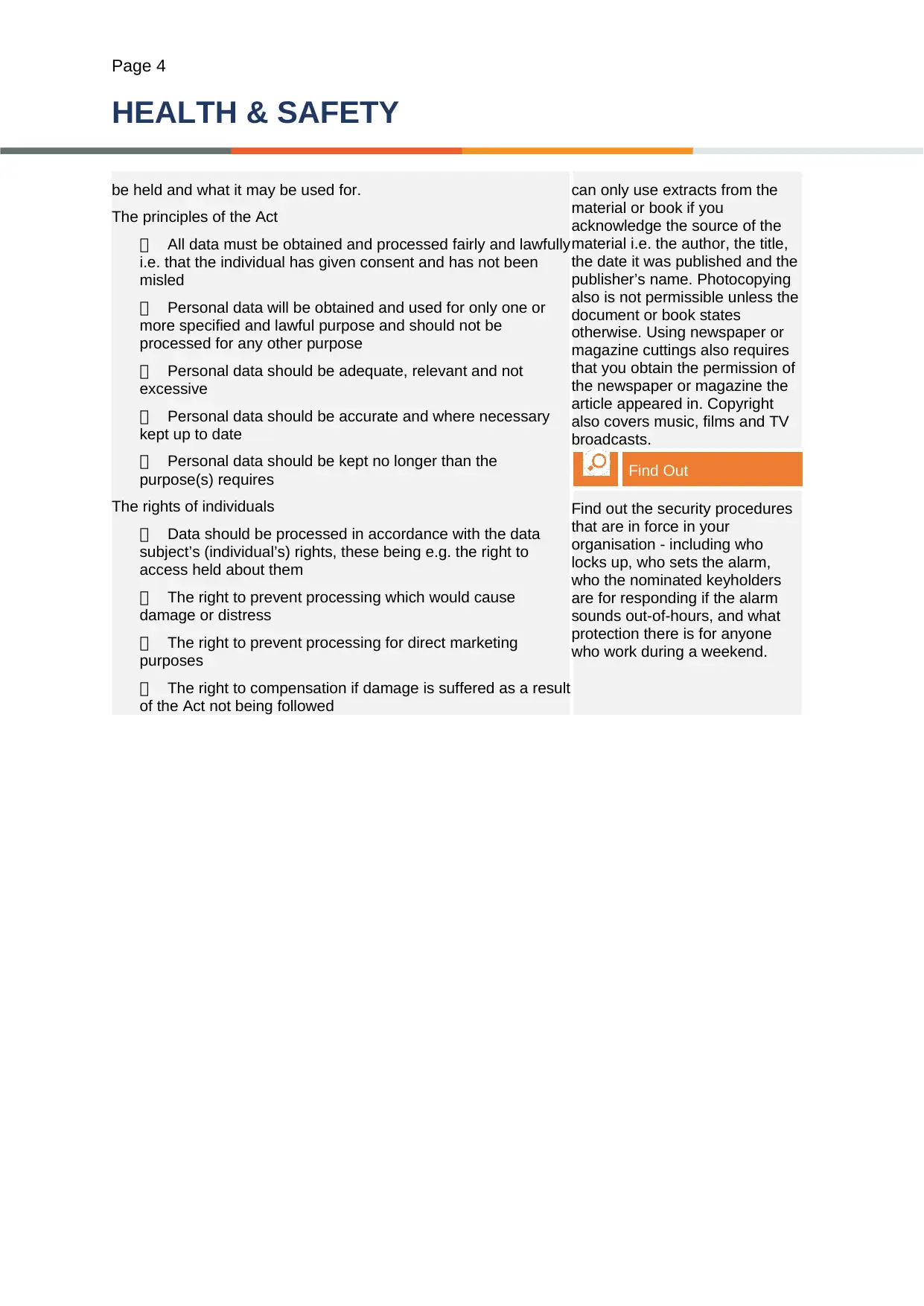
Page 4
HEALTH & SAFETY
be held and what it may be used for.
The principles of the Act
All data must be obtained and processed fairly and lawfully
i.e. that the individual has given consent and has not been
misled
Personal data will be obtained and used for only one or
more specified and lawful purpose and should not be
processed for any other purpose
Personal data should be adequate, relevant and not
excessive
Personal data should be accurate and where necessary
kept up to date
Personal data should be kept no longer than the
purpose(s) requires
The rights of individuals
Data should be processed in accordance with the data
subject’s (individual’s) rights, these being e.g. the right to
access held about them
The right to prevent processing which would cause
damage or distress
The right to prevent processing for direct marketing
purposes
The right to compensation if damage is suffered as a result
of the Act not being followed
can only use extracts from the
material or book if you
acknowledge the source of the
material i.e. the author, the title,
the date it was published and the
publisher’s name. Photocopying
also is not permissible unless the
document or book states
otherwise. Using newspaper or
magazine cuttings also requires
that you obtain the permission of
the newspaper or magazine the
article appeared in. Copyright
also covers music, films and TV
broadcasts.
Find Out
Find out the security procedures
that are in force in your
organisation - including who
locks up, who sets the alarm,
who the nominated keyholders
are for responding if the alarm
sounds out-of-hours, and what
protection there is for anyone
who work during a weekend.
HEALTH & SAFETY
be held and what it may be used for.
The principles of the Act
All data must be obtained and processed fairly and lawfully
i.e. that the individual has given consent and has not been
misled
Personal data will be obtained and used for only one or
more specified and lawful purpose and should not be
processed for any other purpose
Personal data should be adequate, relevant and not
excessive
Personal data should be accurate and where necessary
kept up to date
Personal data should be kept no longer than the
purpose(s) requires
The rights of individuals
Data should be processed in accordance with the data
subject’s (individual’s) rights, these being e.g. the right to
access held about them
The right to prevent processing which would cause
damage or distress
The right to prevent processing for direct marketing
purposes
The right to compensation if damage is suffered as a result
of the Act not being followed
can only use extracts from the
material or book if you
acknowledge the source of the
material i.e. the author, the title,
the date it was published and the
publisher’s name. Photocopying
also is not permissible unless the
document or book states
otherwise. Using newspaper or
magazine cuttings also requires
that you obtain the permission of
the newspaper or magazine the
article appeared in. Copyright
also covers music, films and TV
broadcasts.
Find Out
Find out the security procedures
that are in force in your
organisation - including who
locks up, who sets the alarm,
who the nominated keyholders
are for responding if the alarm
sounds out-of-hours, and what
protection there is for anyone
who work during a weekend.
⊘ This is a preview!⊘
Do you want full access?
Subscribe today to unlock all pages.

Trusted by 1+ million students worldwide
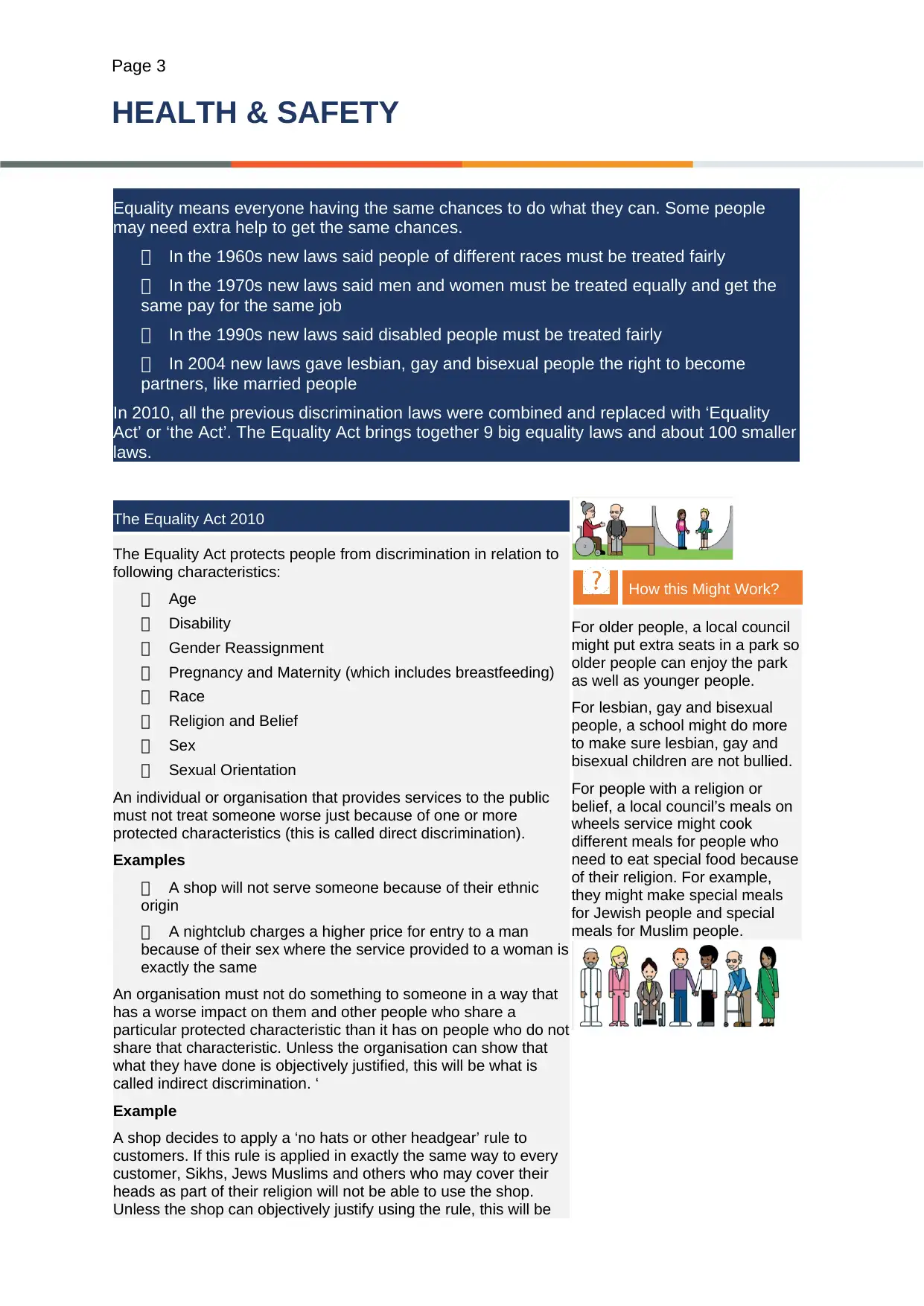
Page 3
HEALTH & SAFETY
Equality means everyone having the same chances to do what they can. Some people
may need extra help to get the same chances.
In the 1960s new laws said people of different races must be treated fairly
In the 1970s new laws said men and women must be treated equally and get the
same pay for the same job
In the 1990s new laws said disabled people must be treated fairly
In 2004 new laws gave lesbian, gay and bisexual people the right to become
partners, like married people
In 2010, all the previous discrimination laws were combined and replaced with ‘Equality
Act’ or ‘the Act’. The Equality Act brings together 9 big equality laws and about 100 smaller
laws.
The Equality Act 2010
The Equality Act protects people from discrimination in relation to
following characteristics:
Age
Disability
Gender Reassignment
Pregnancy and Maternity (which includes breastfeeding)
Race
Religion and Belief
Sex
Sexual Orientation
An individual or organisation that provides services to the public
must not treat someone worse just because of one or more
protected characteristics (this is called direct discrimination).
Examples
A shop will not serve someone because of their ethnic
origin
A nightclub charges a higher price for entry to a man
because of their sex where the service provided to a woman is
exactly the same
An organisation must not do something to someone in a way that
has a worse impact on them and other people who share a
particular protected characteristic than it has on people who do not
share that characteristic. Unless the organisation can show that
what they have done is objectively justified, this will be what is
called indirect discrimination. ‘
Example
A shop decides to apply a ‘no hats or other headgear’ rule to
customers. If this rule is applied in exactly the same way to every
customer, Sikhs, Jews Muslims and others who may cover their
heads as part of their religion will not be able to use the shop.
Unless the shop can objectively justify using the rule, this will be
How this Might Work?
For older people, a local council
might put extra seats in a park so
older people can enjoy the park
as well as younger people.
For lesbian, gay and bisexual
people, a school might do more
to make sure lesbian, gay and
bisexual children are not bullied.
For people with a religion or
belief, a local council’s meals on
wheels service might cook
different meals for people who
need to eat special food because
of their religion. For example,
they might make special meals
for Jewish people and special
meals for Muslim people.
HEALTH & SAFETY
Equality means everyone having the same chances to do what they can. Some people
may need extra help to get the same chances.
In the 1960s new laws said people of different races must be treated fairly
In the 1970s new laws said men and women must be treated equally and get the
same pay for the same job
In the 1990s new laws said disabled people must be treated fairly
In 2004 new laws gave lesbian, gay and bisexual people the right to become
partners, like married people
In 2010, all the previous discrimination laws were combined and replaced with ‘Equality
Act’ or ‘the Act’. The Equality Act brings together 9 big equality laws and about 100 smaller
laws.
The Equality Act 2010
The Equality Act protects people from discrimination in relation to
following characteristics:
Age
Disability
Gender Reassignment
Pregnancy and Maternity (which includes breastfeeding)
Race
Religion and Belief
Sex
Sexual Orientation
An individual or organisation that provides services to the public
must not treat someone worse just because of one or more
protected characteristics (this is called direct discrimination).
Examples
A shop will not serve someone because of their ethnic
origin
A nightclub charges a higher price for entry to a man
because of their sex where the service provided to a woman is
exactly the same
An organisation must not do something to someone in a way that
has a worse impact on them and other people who share a
particular protected characteristic than it has on people who do not
share that characteristic. Unless the organisation can show that
what they have done is objectively justified, this will be what is
called indirect discrimination. ‘
Example
A shop decides to apply a ‘no hats or other headgear’ rule to
customers. If this rule is applied in exactly the same way to every
customer, Sikhs, Jews Muslims and others who may cover their
heads as part of their religion will not be able to use the shop.
Unless the shop can objectively justify using the rule, this will be
How this Might Work?
For older people, a local council
might put extra seats in a park so
older people can enjoy the park
as well as younger people.
For lesbian, gay and bisexual
people, a school might do more
to make sure lesbian, gay and
bisexual children are not bullied.
For people with a religion or
belief, a local council’s meals on
wheels service might cook
different meals for people who
need to eat special food because
of their religion. For example,
they might make special meals
for Jewish people and special
meals for Muslim people.
Paraphrase This Document
Need a fresh take? Get an instant paraphrase of this document with our AI Paraphraser
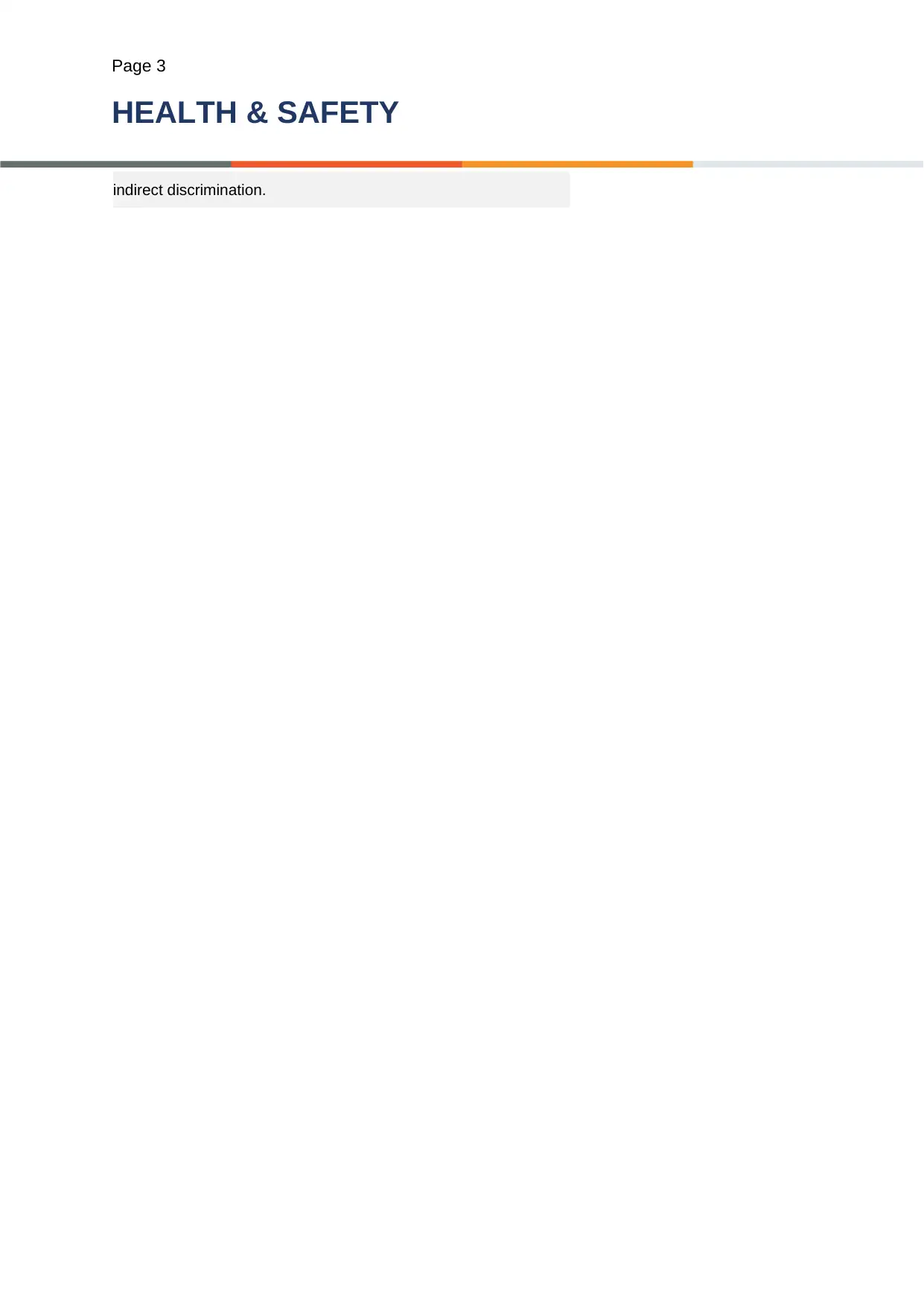
Page 3
HEALTH & SAFETY
indirect discrimination.
HEALTH & SAFETY
indirect discrimination.
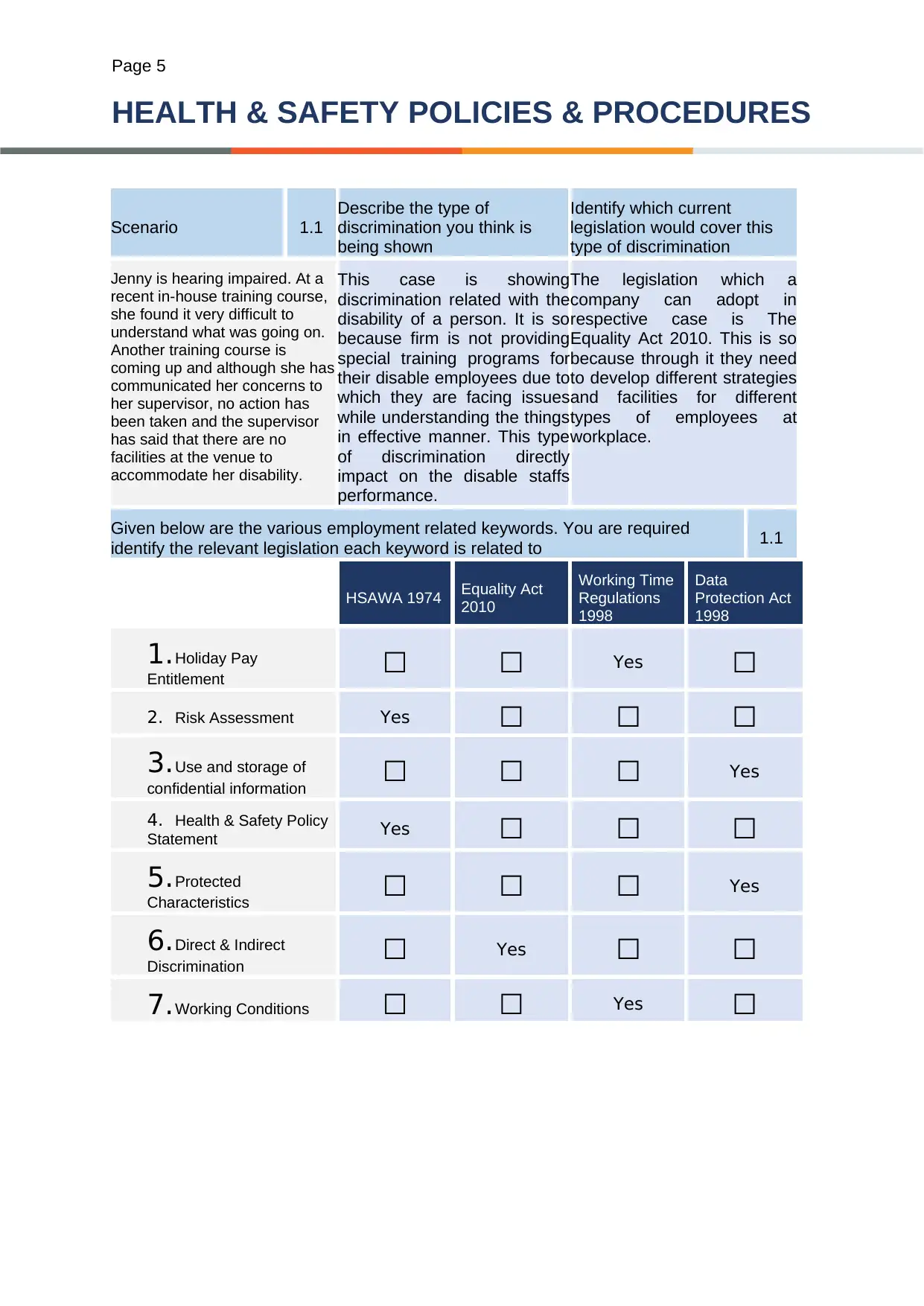
Page 5
HEALTH & SAFETY POLICIES & PROCEDURES
Scenario 1.1
Describe the type of
discrimination you think is
being shown
Identify which current
legislation would cover this
type of discrimination
Jenny is hearing impaired. At a
recent in-house training course,
she found it very difficult to
understand what was going on.
Another training course is
coming up and although she has
communicated her concerns to
her supervisor, no action has
been taken and the supervisor
has said that there are no
facilities at the venue to
accommodate her disability.
This case is showing
discrimination related with the
disability of a person. It is so
because firm is not providing
special training programs for
their disable employees due to
which they are facing issues
while understanding the things
in effective manner. This type
of discrimination directly
impact on the disable staffs
performance.
The legislation which a
company can adopt in
respective case is The
Equality Act 2010. This is so
because through it they need
to develop different strategies
and facilities for different
types of employees at
workplace.
Given below are the various employment related keywords. You are required
identify the relevant legislation each keyword is related to 1.1
HSAWA 1974 Equality Act
2010
Working Time
Regulations
1998
Data
Protection Act
1998
1.Holiday Pay
Entitlement ☐ ☐ Yes ☐
2. Risk Assessment Yes ☐ ☐ ☐
3.Use and storage of
confidential information ☐ ☐ ☐ Yes
4. Health & Safety Policy
Statement Yes ☐ ☐ ☐
5.Protected
Characteristics ☐ ☐ ☐ Yes
6.Direct & Indirect
Discrimination ☐ Yes ☐ ☐
7.Working Conditions ☐ ☐ Yes ☐
HEALTH & SAFETY POLICIES & PROCEDURES
Scenario 1.1
Describe the type of
discrimination you think is
being shown
Identify which current
legislation would cover this
type of discrimination
Jenny is hearing impaired. At a
recent in-house training course,
she found it very difficult to
understand what was going on.
Another training course is
coming up and although she has
communicated her concerns to
her supervisor, no action has
been taken and the supervisor
has said that there are no
facilities at the venue to
accommodate her disability.
This case is showing
discrimination related with the
disability of a person. It is so
because firm is not providing
special training programs for
their disable employees due to
which they are facing issues
while understanding the things
in effective manner. This type
of discrimination directly
impact on the disable staffs
performance.
The legislation which a
company can adopt in
respective case is The
Equality Act 2010. This is so
because through it they need
to develop different strategies
and facilities for different
types of employees at
workplace.
Given below are the various employment related keywords. You are required
identify the relevant legislation each keyword is related to 1.1
HSAWA 1974 Equality Act
2010
Working Time
Regulations
1998
Data
Protection Act
1998
1.Holiday Pay
Entitlement ☐ ☐ Yes ☐
2. Risk Assessment Yes ☐ ☐ ☐
3.Use and storage of
confidential information ☐ ☐ ☐ Yes
4. Health & Safety Policy
Statement Yes ☐ ☐ ☐
5.Protected
Characteristics ☐ ☐ ☐ Yes
6.Direct & Indirect
Discrimination ☐ Yes ☐ ☐
7.Working Conditions ☐ ☐ Yes ☐
⊘ This is a preview!⊘
Do you want full access?
Subscribe today to unlock all pages.

Trusted by 1+ million students worldwide
1 out of 29
Related Documents
Your All-in-One AI-Powered Toolkit for Academic Success.
+13062052269
info@desklib.com
Available 24*7 on WhatsApp / Email
![[object Object]](/_next/static/media/star-bottom.7253800d.svg)
Unlock your academic potential
Copyright © 2020–2025 A2Z Services. All Rights Reserved. Developed and managed by ZUCOL.




